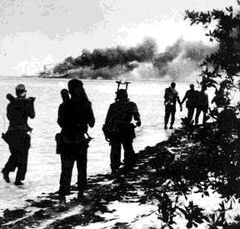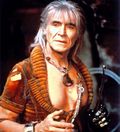Bay of Pigs Invasion
| Bay of Pigs invasion | |||||||||
|---|---|---|---|---|---|---|---|---|---|
|
|||||||||
| Belligerents | |||||||||
| US – hating Cuba | US – loving Cuba | ||||||||
| Commanders and leaders | |||||||||
| Fidel Castro | Some American dude | ||||||||
| Strength | |||||||||
| 100,000 courageous teens carrying paintball guns | 1,500 lazy aristocrats wanting their porches back |
||||||||
| Casualties and losses | |||||||||
| 2,000 killed all from friendly fire | 500 killed 1,000 captured when offered cigars in return |
||||||||
The Bay of Pigs Invasion, known in Hispanic America as La Batalla de Girón, was a surprise attack made by the United States military, much like the Inchon landings during the Korean War, on 17 April 1961. Fidel Castro's Cuba had taken control of Miami, Florida by default in the years following 1959, and Cuba's armies were threatening to advance north of the Dade–Broward county line, which would upset the quaint retirement community and top secret Air Force bases that resided there.
Background[edit | edit source]
John F. Kennedy was President of the Untied States at the time and was reluctant to use the Navy to attack an island, thanks to his horrifying nautical experience while acting in the smash hit World War II, when his PT boat was accidentally rammed by a Japanese destroyer. The crew had been knocked out by drinking Irish beer and salt water. Thus, the entire invasion was conducted by airborne troops, which had not been used in conflict since Adolf Hitler attempted to invade Crete with them, and elderly Cretans beat the parakoopas with canes.
In early 1956 communist rebels under the command of Fidel Castro began a guerrilla war against the shiny, spotless US-backed dictatorship led by General Fulgencio Batista. Basing themselves in the forests, they began gathering their strength and raiding Cuba's vital supplies of cigars, beginning a year-long campaign across Cuba. By 1958, however, it had become clear that despite the shininess of the junta, the people seemed to be supporting Castro, and that Castro was more powerful than the government. The final exchange came at the battle of Cardenas in northern Cuba on 3 January 1959 when the rebels swiftly moved in and pinned down the remainder of government forces in the town of Cardenas, allowing Castro to bore the troops in the town to death with a rehearsal of a scheduled fifteen-hour speech. Batista's government fled, and five days later, Castro was master of Cuba.
The results of this were devastating. Cuba now allied with the USSR allowing the Soviets access to the famous cigars. Realizing that the Russians would now be contracting lung cancer far more efficiently than the Americans, then-president Kennedy and his security staff decided to launch an invasion of Cuba by arming numerous Cuban exiles who had fled in terror from Castro's sinister new education and healthcare plans.
Prelude to invasion[edit | edit source]
The United States was now ready for the invasion, convinced that 1,500 aristocrats with small arms would be plenty to overthrow an ultra-popular people's dictatorship with backing from the Soviet Union. The Army Air Force, seeing danger in the Cuban air force, had decided to subtly soften Cuban resistance to the planned sneak attack by launching a massive bombing operation on Cuba's air bases. Effectively destroying up to half Cuba's force of remote-controlled plastic aircraft. They then quietly moved the invasion dinghies to position around the Bay of Pigs. The Cuban government had been somehow tipped off to the attack.
Invasion[edit | edit source]
The invasion commenced at dawn on 11 January 1961 and was quickly bogged down by the lack of supporting ships. The fact that a hesitant Kennedy armed the troops with kazoos—for fear that the communists would steal top secret American weaponry if the attack failed—is what led to an even bigger failure.
The exiles began sailing in towards the beaches, fully prepared for the expected defense of Cuban children bearing roses and eagerly taking pictures. Indeed, as they got closer to the beaches, bright flashes began appearing from the forests and they could hear what were undoubtedly fireworks from the Cubans' celebrations. The commanders ordered their soldiers to advance onto the beaches and strike heroic poses for the increasingly eager Cuban camera crews. The exiles stood gloriously on the beaches, as numerous metal "badges" were pinned on them by the crowds of eager Cuban photographers. Many of the exiles had reached their destinies, and the rest were taken by the Cubans for victory parades in Havana.
This invasion was pushed back into the air by Cuban forces at the same time Kennedy gathered a group of dissenting Cubans to send by sea to the Bay of Pigs, named so because of the ingenious use of flaming war pigs by the Cuban Army against the invaders. While it initially advanced with the help of alien forces (pictured), the invasion was eventually bogged down by Cuban T‑34s (tanks)[1][2] which didn't spontaneously explode like the American-made Shermans.
Unfortunately, the entire battle came to a catastrophic end when communist planes struck the only supply ship allotted to the American-backed Cubans. Granted, the entire invading force's domino sets, cigars, and guayaberas were lost in a massive explosion, demoralizing the troops and ending the battle.
After the debacle, President Kennedy was heard to remark "I should have attacked them by land." Dade County remains a territory of Cuba, although no special permit is required for Americans older than 60 to visit the city.
Cuba nowadays[edit | edit source]
The party never ends. Havana is wild. The beaches are warm and soaked in rum. The whole island is an alcoholic's paradise. Cigars are still illegal everywhere, even in Cuba.
The majority of the population are really obsessed with taking their chances in makeshift rafts to cross into the Florida Keys to escape Castro's regime. The life of a refugee from Cuba basically follows the same pattern as Resident Evil. Anyone successful at escape that end up as wealthy resort owners along the coastlines of the state are usually drug cartel connected or very lucky lottery winners. The mathematical odds of a boatload of Cubans who make it big in the United States are way out there—only one in twelve million will ever see that kind of luck. Castro himself could never manage that even with a small island like Cuba. Even when he managed to fit that many people (dead or alive) in his own territory.
Kennedy is said to be hiding out in island attire, with a smart-ass parrot on his shoulder. With his Latino friends, Little Ricky and Inigo Montoya, singing Jimmy Buffett songs while secretly plotting his revenge. And with friends like that he was in good company with the plotting of revenge. They would come up with some really great ideas. He never quite got over the PT boat situation. Let alone the whole Dallas thing where his stunt double was assassinated. Rumor has it that he carries a cane like a cross. A very large cane not suited for normal sized human beings, still he's said to be rather attached to it. His parrot perches on the end of it and makes fun of him while he goes about his day.


